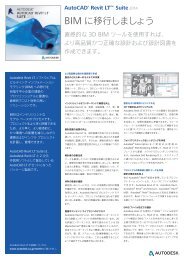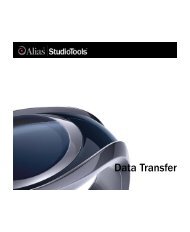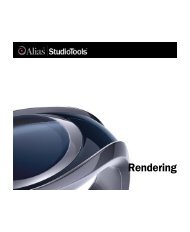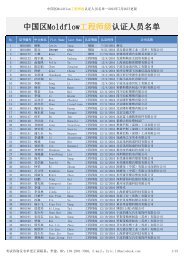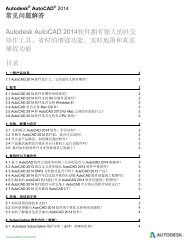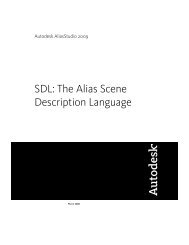You also want an ePaper? Increase the reach of your titles
YUMPU automatically turns print PDFs into web optimized ePapers that Google loves.
ASCII DXF Files<br />
This section describes the format of ASCII DXF files. It contains information<br />
that is needed only if you write your own programs to process DXF files or<br />
work with entity information obtained by AutoLISP ® and ObjectARX<br />
applications.<br />
General DXF File Structure<br />
Essentially a DXF file is composed of pairs of codes and associated values. The<br />
codes, known as group codes, indicate the type of value that follows. Using<br />
these group code and value pairs, a DXF file is organized into sections, composed<br />
of records, which are composed of a group code and a data item. Each<br />
group code and value is on its own line in the DXF file.<br />
Each section starts with a group code 0 followed by the string, SECTION. This<br />
is followed by a group code 2 and a string indicating the name of the section<br />
(for example, HEADER). Each section is composed of group codes and values<br />
that define its elements. A section ends with a 0 followed by the string<br />
ENDSEC.<br />
It may be helpful to produce a DXF file from a small drawing, print it out,<br />
and refer to it while reading the information presented in this section.<br />
The overall organization of a DXF file is as follows:<br />
■<br />
■<br />
■<br />
HEADER section. Contains general information about the drawing. It consists<br />
of an AutoCAD database version number and a number of system<br />
variables. Each parameter contains a variable name and its associated<br />
value.<br />
CLASSES section. Holds the information for application-defined classes,<br />
whose instances appear in the BLOCKS, ENTITIES, and OBJECTS sections<br />
of the database. A class definition is permanently fixed in class hierarchy.<br />
TABLES section. Contains definitions for the following symbol tables.<br />
APPID (application identification table)<br />
BLOCK_RECORD (block reference table)<br />
DIMSTYLE (dimension style table)<br />
LAYER (layer table)<br />
LTYPE (linetype table)<br />
STYLE (text style table)<br />
UCS (User Coordinate System table)<br />
146 | Appendix A Drawing Interchange File Formats



